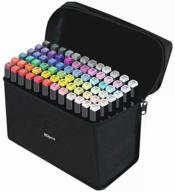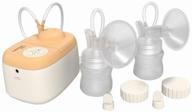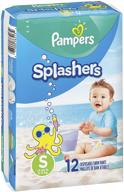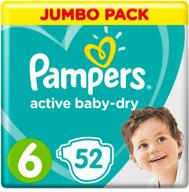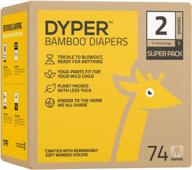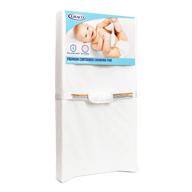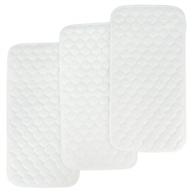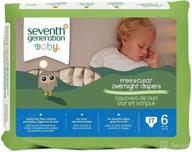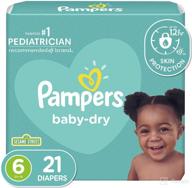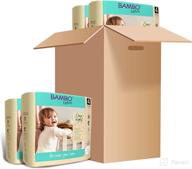Choosing the Right Diaper Size
Selecting the proper diaper size for your baby is crucial for avoiding leaks and blowouts. While it may seem straightforward, finding the ideal fit can require some trial and error. Here are some tips on determining the right size diaper for your child's needs.
Consider Your Baby's Weight
Most diaper brands provide a weight range guideline indicating which sizes are appropriate for babies at different weights. For example:
- Newborn size: Up to 10 lbs
- Size 1: 8-14 lbs
- Size 2: 12-18 lbs
- Size 3: 16-28 lbs
- Size 4: 22-37 lbs
- Size 5: Over 27 lbs
While these ranges are a helpful starting point, remember that factors like body shape also impact proper fit. Every baby is unique!
Pay Attention to Fit Around the Legs and Waist
A diaper that fits well should:
- Have absorbent padding that reaches the front of the diaper
- Fit snugly around the legs without gaps or compression marks
- Sit at or just below the belly button when fastened at the waist
If you notice red marks, indentation, or gapping around the thighs or waist, try sizing up or down as needed.
Conduct a "Pinch Test"
When your baby is lying down, gently pinch the diaper at the thighs, waist, and center. You should not be able to pinch more than about half an inch of excess material. If you can pinch more, the diaper is likely too large.
Monitor for Leaks and Adjust Accordingly
Leakage around the legs or out the back of the diaper often signals it's time to size up. Consider going up a size if:
- You consistently experience more than 2-3 leaks per day
- There are gaps between the diaper and your baby's legs
- The front or back of the diaper saturates quickly
Frequent blowouts could mean it's time to switch to a brand with a higher absorbency level or to size down if the diaper is loose.
Allow for Growth Spurts
Babies grow rapidly in the first year of life. When you notice your child nearing the top weight limits for their current size, buy a pack of the next size up so you have it ready when needed. Most babies go up at least one diaper size every 1-2 months early on.
With a bit of trial and error, you'll soon discover the perfect diaper fit for your little one's needs. Just listen for those crinkly sounds to know it's working!
Absorbency Levels Explained
When selecting diapers, you'll notice they come marked with various absorbency levels. This indicates how much liquid the diaper is designed to hold. Choosing the right absorbency for your child can help prevent leaks.
Absorbency Ratings
Most brands classify absorbency using a numbering system, typically ranging from 1 to 6, with higher numbers meaning greater absorbency capacity. For example:
- Level 1: Light absorbency for newborns
- Level 2: Medium absorbency for crawling babies
- Level 3: Moderate-heavy absorbency for active toddlers
- Level 4: Extra-absorbent for older babies at night
- Level 5-6: Maximum or overnight absorbency
When to Use Each Level
Here are some general guidelines on which absorbency rating may work best by age and time of day:
| Age | Daytime | Overnight |
|---|---|---|
| Newborn | Level 1 | Level 1 or 2 |
| 3-6 months | Level 2 | Level 3 |
| 6-12 months | Level 3 | Level 4 |
| 12-24 months | Level 4 | Level 5 |
Factors to Consider
When deciding on absorbency level, also take into account:
- Baby's size: Larger babies may need higher absorbency.
- Frequency of changing: Less frequent changes require higher absorbency.
- Time of day: Use higher levels at night when longer stretches between changes are expected.
- Activity level: Active walkers and climbers may need more absorbency.
- Baby's hydration: Well-hydrated babies may urinate more, needing higher absorbency.
Troubleshooting Tips
If you notice leaking or overflow, try sizing up on absorbency level. For frequent leaks, go up 1-2 levels. For overnight leaks, go up 1 level. Reducing liquid intake before bed can also help for nighttime issues.
Conversely, if diapers are not becoming saturated and seem excessively bulky, size down on absorbency level to save money and avoid discomfort. Pay attention to patterns and adjust as needed.
Similar products
Overnight vs Daytime Diapers
When it comes to diapers, using the right type for the time of day can make a difference in preventing leaks and keeping your baby comfortable. Here's how overnight and daytime diapers compare.
Absorbency
The main difference between overnight and daytime diapers is absorbency level. Overnight diapers are designed to be ultra absorbent to last for extended periods of time without leaks.
- Overnight diapers typically rate at a 4-6 on the absorbency scale.
- Daytime diapers usually rate at a 2-4.
Higher absorbency comes from features like:
- Added sodium polyacrylate crystals to pull moisture into the core
- Extra cellulose padding
- An inner absorbent layer to distribute wetness
Fit
Many overnight diapers also have a snugger fit at the legs and waist to prevent gaps that can lead to leaks at night.
- Some brands use elastic waistbands or gathered side panels.
- Adjustable tape tabs help get just the right fit.
Wetness Indicators
Overnight diapers commonly feature wetness indicators that change color to signal when a diaper is damp. This allows you to efficiently check your sleeping baby's diaper in the dark.
When to Use
- Use overnight diapers when longer than 4-5 hours will pass between changes.
- Use daytime diapers for changes every 1-3 hours.
Keep overnight diapers on hand for naps over 2 hours. Have your daytime supply ready for errands, playtime, and general use.
Consider Combining
For heavy wetters, you can layer an overnight diaper inside a daytime diaper for added protection. Just be sure to size up to avoid a too-snug fit.
Choosing the right diaper for day versus night can help minimize messes, leaks, and baby discomfort. See which options work best for your child's routine.
Top products in 👶 Disposable Diapers
Leak Protection Features
Diaper manufacturers offer various innovations to help prevent frustrating leaks. Here are some common leak protection features to look for when choosing a diaper brand.
Wetness Indicators
Many diapers now have panels on the outside that change color when wet. These allow you to quickly check if a diaper needs changing without undressing your baby.
- Wetness indicators are helpful during overnight changes and naps.
- Look for blue or yellow dots that turn green or disappear when damp.
Leg Cuffs
Leak barriers along the leg openings prevent fluid from escaping out the legs and onto clothing.
- Options include soft elastic leg cuffs or gathered casing.
- A snug but gentle seal is key.
Absorbent Channels
Channels running along the diaper core quickly pull wetness from the surface into deeper absorbent layers.
- Channels are often lined with moisture-wicking material.
- This helps prevent side leaks and oversaturation in one spot.
Pockets and Contours
Strategic padding placement targets wetness zones for better coverage.
- Deeper pockets at the back absorb nighttime wetness.
- Shaped contours provide a custom fit around the legs and waist.
Liner and Shell Design
Separating the moisture-wicking liner from the absorbent core isolates wetness and contains leaks.
- The liner rests against the skin while the core absorbs.
- The waterproof outer shell keeps clothing protected.
Test different diaper leak protection features to find your best defense against accidents and surprises!
Special Fit Diapers for Active Babies
When babies start moving around more, containment becomes key. Special fit diapers are designed to keep up with active babies who crawl, walk, and explore.
Stretchy Sides
Look for diapers with stretchy fabric panels on the sides. These allow for a flexible range of motion.
- The panels expand and adapt as baby twists, kicks, and squats.
- Elasticity reduces gaps that can lead to leaks.
Snug Fit
Diapers made for movers and shakers hug closely to the body to prevent shifting and ride-up.
- Contoured and gathered cores move naturally with baby.
- Closely-cut leg openings maintain coverage.
- Stretchy waistbands and secure closure prevent sagging.
Reinforced Tabs
Look for wide, reinforced fastening tabs to withstand tugging and friction from constant movement without loosening.
- Wider tapes distribute tension over more surface area.
- Strong adhesive prevents frequent re-sticking.
Wetness Protection
Higher absorbency levels and rapid moisture distribution help active diapers withstand activity.
- Quick-wicking liner pulls wetness into absorbent core.
- Padding channeled for optimal coverage front and back.
- Super-absorbent polymer traps fluid away from skin.
Consider sizing up in absorbency level to accommodate an energetic baby's needs.
Breathability
Breathable outer fabrics like cotton allow air flow to keep skin drier during active play. Look for diapers designed with ventilation in mind.
Test a few sporty diaper designs to find the best match for your strong, speedy, and active baby!
Another interesting products
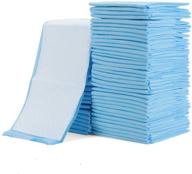

3 Review

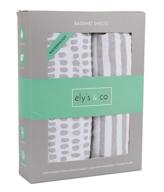

4 Review

Eco-Friendly and Biodegradable Diaper Options
For environmentally conscious parents, there are some great options when it comes to earth-friendly disposable diapers. Here are some features to look for.
Plant-Based Materials
Many eco diapers use plant-derived and sustainable materials like:
- Bamboo viscose fibers
- Organic cotton
- Wheat straw
- Sugarcane
These renewable materials replace petroleum-based plastics found in traditional diapers.
Reduced Chemicals
Eco diapers avoid harsh chemicals like chlorine, perfumes, lotions, and dyes. They use safer alternatives like:
- Plant-based liners
- Water-based adhesives
- Hypoallergenic fibers
This reduces exposure to irritants against baby's delicate skin.
Increased Biodegradability
Many eco diapers break down faster after disposal to minimize landfill waste. Look for:
- No plastic polymer superabsorbent gel
- 50% or more plant-based content
- Compostable under industrial conditions
Reduced Packaging
Eco diapers use minimal or recyclable packaging like:
- Plant-based bioplastic wrapping
- Bags made with recycled paper
- Cardboard boxes from sustainably-managed forests
This further reduces their environmental impact.
Third-Party Testing
Look for reputable eco labels like Forest Stewardship Council (FSC), EcoLogo, and Nordic Swan for third-party certification of earth-friendly practices and materials.
Choosing eco diapers benefits both baby and the planet. See how these greener options compare for your family.
Saving Money on Diapers with Store Brands
Diapers can be a big expense, especially in baby's first couple of years. Store brands allow you to cut costs while still getting quality and performance.
Lower Prices
National store brands like Target's Up&Up, Walmart's Parent's Choice, or Kroger's Comforts save 30-50% over premium name brands. This adds up with the thousands of diapers used in babyhood.
Similar Construction
Many store brands are manufactured by the same major companies that make leading national brands. Materials and construction are comparable:
- Soft quilted liner
- Super-absorbent polymer core
- Outer moisture-proof backing
- Reputable adhesives
Range of Sizes and Styles
Store brands offer all the standard sizes from newborn through size 6. Many also have overnight, sensitive, and eco-friendly varieties.
Frequent Sales and Promotions
Often store brands go on sale or you can get extra savings like:
- Buy one, get one half off
- Buy two, get a $5 gift card
- Spend $100, save $25 instantly
You can stock up and maximize these deals.
Membership Discounts
Warehouse stores like Costco offer low member prices on large packs of quality diapers and wipes.
Buy in Bulk Online
Ordering store brand boxes in multi-packs online can increase savings on the cost per diaper. Opt for in-store pickup to avoid delivery fees.
Compare Reviews
Check parent feedback and reviews online to identify the best performing store brands. Look for ones rated highly for absorbency, durability, and leak protection.
With a little research, store brand diapers can be an effective way to help tame the major expense of diapering a baby from newborn through potty training.
How Amazon Prime Benefits Disposable Diaper Buyers
For parents using disposable diapers, an Amazon Prime membership can really pay for itself through savings, convenience, and perks.
Free and Fast Shipping
Prime members get free two-day shipping on all eligible purchases, including big bulky boxes of diapers and wipes. This avoids the higher shipping costs typically added to these essential items.
The ability to quickly reorder when supplies run low without waiting or paying extra for delivery is a huge perk for busy parents.
Discount Programs
Amazon offers a monthly subscription program called Prime Pantry for household goods. This allows you to save up to 15% when you schedule regular diaper deliveries. You can customize frequency and quantity.
Prime members can create Dash Buttons that reorder diapers with one click when supplies get low. This eliminates emergency trips to the store.
Access to Exclusive Deals
Amazon Prime Day and other special sales offer deep discounts to members on popular diaper brands. This is a great chance to stock up and save even more.
Lightning deals offer short term savings on diapers and wipes throughout the year. Prime members get 30 minute early access to take advantage of limited-time deals.
Streamlined Shopping Experience
With Prime, you can save diapers and wipes you order frequently to Dash buttons and Lists for easy reordering. This simplifies the process of restocking essentials.
Overall, a Prime membership canSimplify your life as a busy parent using disposable diapers. The conveniences and savings really add up over time.
What Are The Benefits Of Using Disposable Diapers?
Disposable diapers have several benefits that make them a popular choice for parents. Here are some of the benefits of using disposable diapers:
What Are The Drawbacks Of Using Disposable Diapers?
While disposable diapers have many benefits, there are also some drawbacks to consider:






